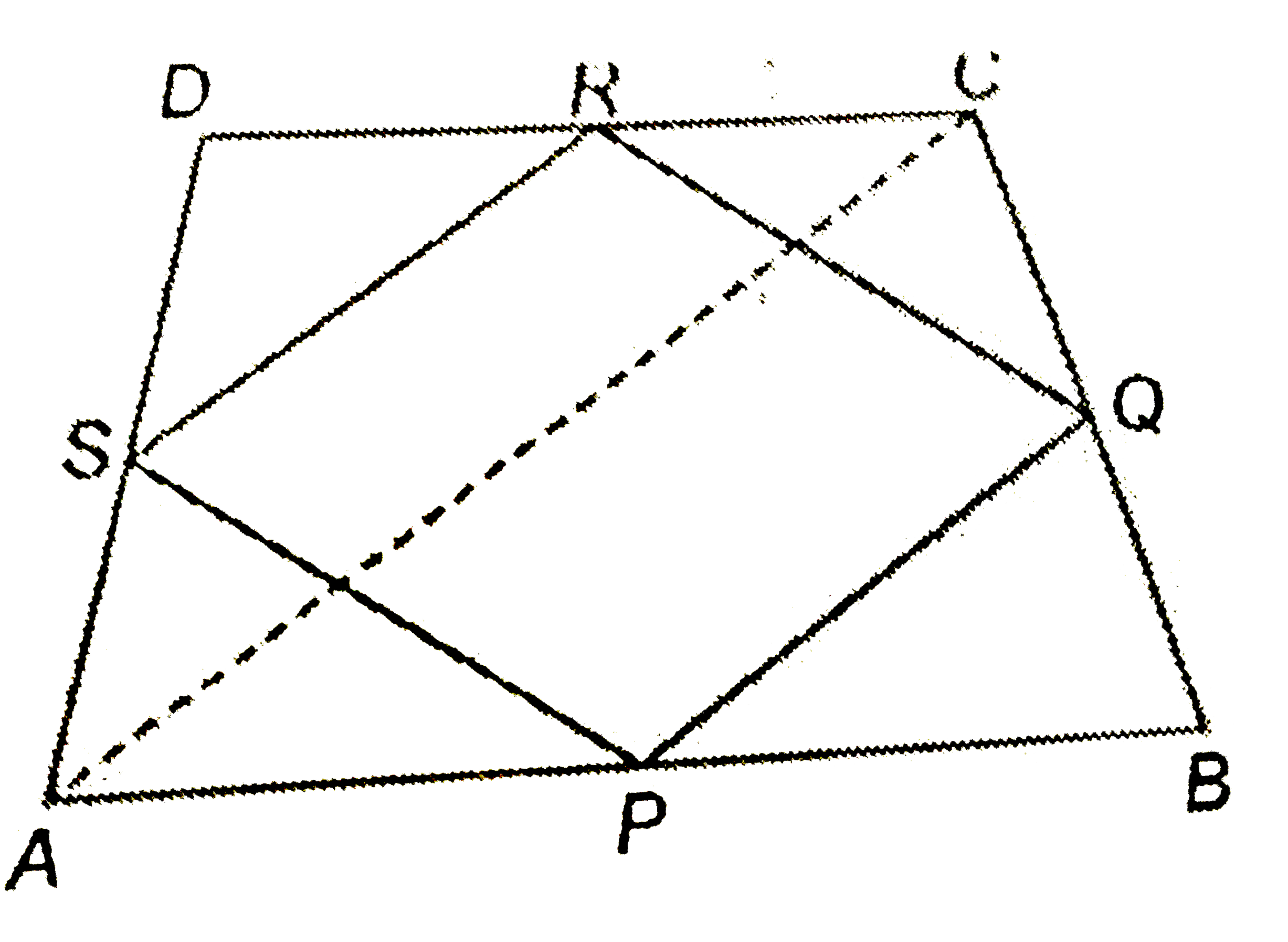Prove that the line segments joints joining the mid-points of the adjacent sides of a quadrilateral from a parallelogram.
To prove that the line segments joining the midpoints of the adjacent sides of a quadrilateral form a parallelogram, we will follow these steps:
Step 1: Identify the midpoints
Let quadrilateral ABCD be given. We denote the midpoints of the sides as follows:
- P is the midpoint of side AB.
- Q is the midpoint of side BC.
- R is the midpoint of side CD.
- S is the midpoint of side AD.
Step 2: Draw the diagonals
Now, we will draw the diagonal AC of the quadrilateral ABCD.
Step 3: Analyze triangle ABC
In triangle ABC, since P and Q are the midpoints of sides AB and BC respectively, by the Midpoint Theorem, we can conclude that:
PQ∥AC
This means that the line segment PQ is parallel to the diagonal AC.
Step 4: Analyze triangle ADC
Next, we consider triangle ADC. Here, R and S are the midpoints of sides CD and AD respectively. Again, by the Midpoint Theorem, we can conclude that:
RS∥AC
This means that the line segment RS is also parallel to the diagonal AC.
Step 5: Establish parallelism between PQ and RS
Since both PQ and RS are parallel to AC, we can state that:
PQ∥RS
Step 6: Draw the other diagonal
Now, we will draw the diagonal BD of the quadrilateral ABCD.
Step 7: Analyze triangle ABD
In triangle ABD, P and S are the midpoints of sides AB and AD respectively. By the Midpoint Theorem, we can conclude that:
PS∥BD
Step 8: Analyze triangle BCD
In triangle BCD, Q and R are the midpoints of sides BC and CD respectively. By the Midpoint Theorem, we can conclude that:
QR∥BD
Step 9: Establish parallelism between PS and QR
Since both PS and QR are parallel to BD, we can state that:
PS∥QR
Step 10: Conclude that PQRS is a parallelogram
Now we have established that:
1. PQ∥RS
2. PS∥QR
Since both pairs of opposite sides are parallel, we conclude that quadrilateral PQRS is a parallelogram.
Final Conclusion
Thus, we have proved that the line segments joining the midpoints of the adjacent sides of a quadrilateral form a parallelogram.
---
Let quadrilateral ABCD be given. We denote the midpoints of the sides as follows:
- P is the midpoint of side AB.
- Q is the midpoint of side BC.
- R is the midpoint of side CD.
- S is the midpoint of side AD.
Now, we will draw the diagonal AC of the quadrilateral ABCD.
In triangle ABC, since P and Q are the midpoints of sides AB and BC respectively, by the Midpoint Theorem, we can conclude that:
PQ∥AC
This means that the line segment PQ is parallel to the diagonal AC.
Next, we consider triangle ADC. Here, R and S are the midpoints of sides CD and AD respectively. Again, by the Midpoint Theorem, we can conclude that:
RS∥AC
This means that the line segment RS is also parallel to the diagonal AC.
Since both PQ and RS are parallel to AC, we can state that:
PQ∥RS
Now, we will draw the diagonal BD of the quadrilateral ABCD.
In triangle ABD, P and S are the midpoints of sides AB and AD respectively. By the Midpoint Theorem, we can conclude that:
PS∥BD
In triangle BCD, Q and R are the midpoints of sides BC and CD respectively. By the Midpoint Theorem, we can conclude that:
QR∥BD
Since both PS and QR are parallel to BD, we can state that:
PS∥QR
Now we have established that:
1. PQ∥RS
2. PS∥QR
Thus, we have proved that the line segments joining the midpoints of the adjacent sides of a quadrilateral form a parallelogram.
Topper's Solved these Questions
Similar Questions
Using vector method, prove that the line segments joining the mid-points of the adjacent sides of a quadrilateral taken in order form a parallelogram.
View SolutionProve that the figure formed by joining the mid-points of the pairs of consecutive sides of a quadrilateral is a parallelogram.

View Solution
Knowledge Check
The line segments joining the midpoints of the adjacent sides of a quadrilateral form
Aa parallelogramBa rectangleCa squareDa rhombusThe meeting point of adjacent sides of a quadrilateral is called a___
AVertexBSideCcornerDSegment
Show that the line segments joining the mid-points of the opposite sides of a quadrilateral bisect each other.
View SolutionShow that the line segments joining the mid-points of the opposite sides of a quadrilateral bisect each other.
View SolutionShow that the line segments joining the mid-points of opposite sides of a quadrilateral bisects each other.
View SolutionThe figure formed by joining the mid-points of the adjacent sides of a quadrilateral is a parallelogram (b) rectangle square (d) rhombus
View SolutionThe figure formed by joining the mid-points of the adjacent sides of a quadrilateral is a parallelogram (b) rectangle (c) square (d) rhombus
View SolutionProve that the quadrilateral formed by joining the mid-points of the pairs of consecutive sides of a quadrilateral is a parallelogram.
View Solution
